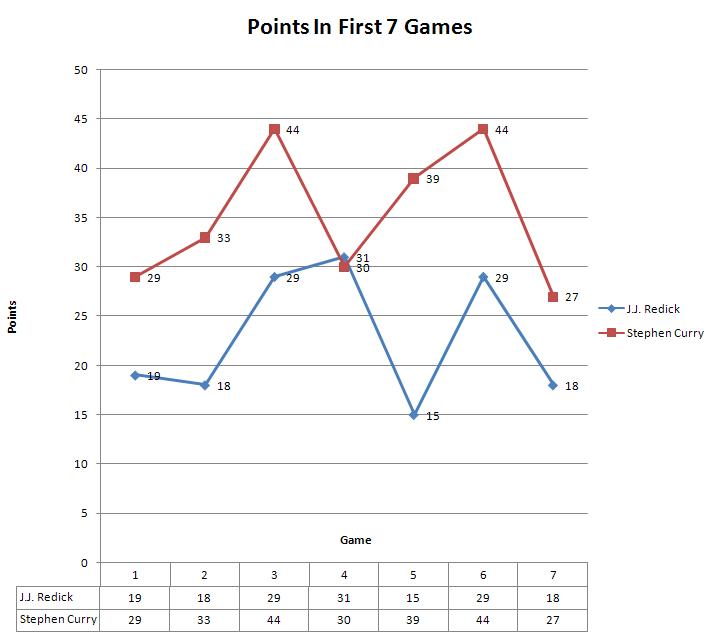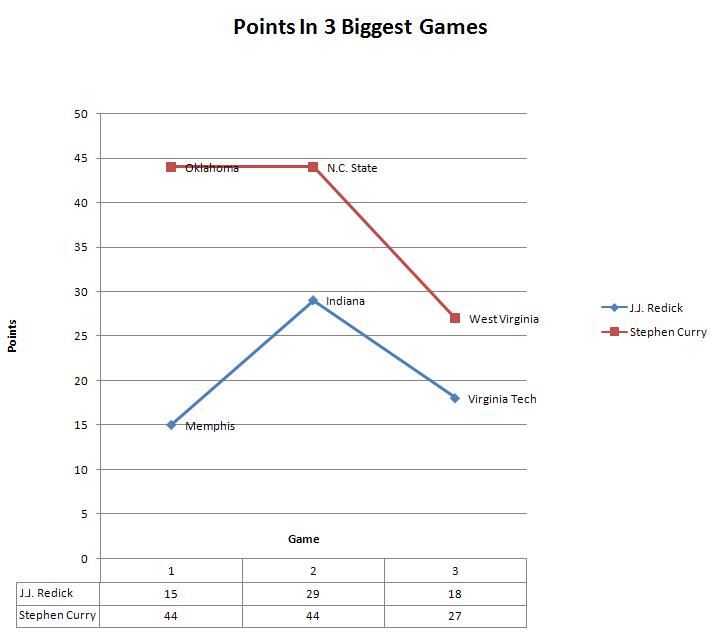Who's better: J.J. Redick or Stephen Curry?
Forget about their silky strokes, the way they relish in quieting road crowds, the fact that their offenses completely revolve around them or the reality that defensive schemes are tailored to curb their unique talents. It's hard to compare Redick, the Duke legend, and Curry, Davidson's star, mostly because it's hard to compare Duke and Davidson, in terms of playing atmosphere, schedule, pressure, supporting cast and more.
Then again, that's exactly what we're going to do over the course of the season: compare Redick and Curry, not for the sake of deeming a winner, but to weigh the merits of each against another similar player. This debate has raged on message boards over the past few weeks, but we hope that our forum fosters a conversation that proves more ongoing. The forthcoming installments won't necessarily be posted tomorrow--this is a season-long exercise in trying to determine who is better, and if never come to a conclusion, that's fine, too.
Curry came into his own in last year's NCAA Tournament, when he turned the Wildcats into the nation's newest Cinderella darling before they finally lost in the Elite 8. In those March weeks, the country became aware of Curry's shooting prowess. Even the most venerable NBA stars came out to witness the spunky guard from North Carolina's newest basketball power, and everyone left impressed. It still doesn't matter that Curry may be too small to be a force in the NBA. He's a phenomenal college player, and in a world of one-and-dones and eighth-grade recruiting rankings and perpetual NBA mock drafts, we must learn to appreciate such a simple rarity for what it is. Redick, after all, was similar to Curry in this sense. He still hasn't fit into an NBA system--at least not the one he's in--but that shouldn't diminish the enormous footprint he left in Cameron Indoor Stadium. The fact that he doesn't score anymore doesn't change the fact that he scored more than any other player at Duke.
With that in mind, let's start with the obvious: statistics.
Curry first drew Redick comparisons last March, so we should begin by weighing Curry's statistics from this year against Redick's senior year numbers (after all, this may be Curry's last season in college). We'll measure statistics from Curry and Redick's first seven games--and before you say anything, we're going to discount Curry's numbers from his 0-point performance against Loyola, when he accepted the game-long double-team, took himself out of the offense by standing in the corner and the Wildcats won by 30 points. We should also remember that while Davidson's Southern Conference slate is obviously lighter than Duke's ACC schedule, the teams' early season schedules in 2008 and 2005 aren't completely different. In 2005, Duke played Boston University, Seton Hall, Davidson (without Curry), Drexel and No. 11 Memphis in New York, at No. 17 Indiana and Virginia Tech. This year, Davidson played Guilford, JMU, at No. 14 Oklahoma, Winthrop, Florida Atlantic, Loyola, N.C. State and West Virginia in New York. The schedule edge, of course, goes to Redick, but the disparity before the New Year isn't so wide. (We'll discuss the teams' schedules and supporting casts in later posts, and while we know that affects the stars' statistics, bear with us for now.)
Through seven games, Curry played fewer minutes than Redick (34.4 to 35.5), shot better from the line (87.3 to 86.3 percents), averaged more rebounds (2.9 to 1.7) and steals (3.1 to 1.1) and, as the team's new point guard, many more assists (6.9 to 2.1). Redick was better from 3-point range (44.1 to 37.8 percents), and the two both shot 47 percent from the field.
Which brings us to scoring average, the kingpin of statistics, where Curry is more regal than Redick. Not including the 0-point aberration, Curry is averaging 35.1 points per game, whereas Redick posted (only!) 22.7 points per game in seven games. If you want to count the Loyola game and include Redick's next game, a win over Pennsylvania, the contrast is still staggering. Curry is then averaging 30.8 points per game and Redick is up to just a 22.9 average. (Will voters, like we did, ignore the Loyola game when determining National Player of the Year awards? Curry's numbers will be that much more astounding if they do.) Here's a game-by-game breakdown of their scoring outputs:

Duke fans will, of course, have reservations about judging the two players by statistics alone. What about if we look at the two players' numbers against the three best teams on their early schedules? For Davidson, that means a road loss at Oklahoma, a pseudo-home win over N.C. State in Time Warner Cable Arena and a neutral court victory over West Virginia. For Duke, the games are a neutral floor win over Memphis in New York (is that neutral?), a big road win in the ACC/Big Ten Challenge over Indiana (remember Marco Killingsworth?) and a home win over Virginia Tech, best remembered by Sean Dockery's game-winning halfcourt heave. The graph for those three games:

Duke, it should be noted, won all three of its toughest games before the break that year, while Davidson finished 2-1. And although there are many reasons for it--which we will examine in future installments of this series--it appears that Curry outperformed Redick, at least in the early season. We wouldn't be surprised to see the Wildcat guard post better numbers than Redick did over the course of the season, because he might average 35 points per game against Southern Conference opponents.
But numbers are not always truthful--this we all know. Are they lying in this case? Is Curry better than Redick was? What other factors should we consider as we continue to explore this comparison? Does it matter that Curry is a point guard and not a shooting guard now? How different is it that Redick played for Duke, and not Davidson?
Get The Chronicle straight to your inbox
Signup for our weekly newsletter. Cancel at any time.
